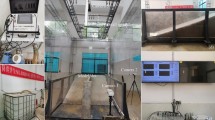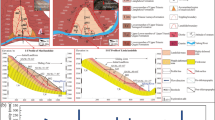Abstract
In this study, two different research methods are applied to investigate the evolution mechanism and rainfall warning criteria for Maijianwo slope located in Henan Province, China. On the one hand, an indoor-model test is performed under artificial rainfall and based on similarity theory. A set of monitoring system is utilized to track the moisture content, deformation and cracks of critical points of the model during the test. On the other hand, the numerical simulation is carried out to provide an insight into the variation of unstable zone and factor of safety for the landslide with the increasing cumulative rainfall. Results indicate that the evolution process of Maijianwo slope is composed of three stages of initiating, accelerating and failure respectively, and stability of slope decreases gradually as cumulative rainfall increases. Based on the evolution mechanism of retrogressive landslide verified by both model test and numerical simulation, cracking time of critical positions on the slope prior to each stage were set as the initiating time of each stage and the cumulative rainfall associated with each initiating time (E1 = 75 mm, E2 = 180 mm) has been defined as the warning criteria for the Maijianwo slope. As the cumulative rainfall in Maijianwo slope reaches 75 and 180 mm, the landslide orange and red warning codes are issued, respectively. Otherwise, the slope is in a safe condition when the cumulative rainfall is less than 75 mm.











Similar content being viewed by others
References
Acharya KP, Bhandary NP, Dahal RK, Yatabe R (2016) Seepage and slope stability modelling of rainfall-induced slope failures in topographic hollows. Geomat Nat Hazards Risk 7(2):721–746
Bommer JJ, Rolo R, Mitroulia A, Berdousis P (2002) Geotechnical properties and seismic slope stability of volcanic soils. In: 12th European conference on earthquake engineering, September, paper reference 695, London
Dahal RK, Hasegawa S (2008) Representative rainfall thresholds for landslides in the Nepal Himalaya. Geomorphology 100(3–4):429–443
Fukushima S, Tatsuoka F (1984) Strength and deformation characteristics of saturated sand at extremely low pressure. Soils Found 24(4):30–48
GeoSlope International Ltd (2007) Slope/W user's guide for slope stability analysis. GEO-SLOPE International Ltd., Calgary, Alta
Guzzetti F, Peruccacci S, Rossi M, Stark CP (2007) Rainfall thresholds for the initiation of landslides in central and southern Europe. Meteorol Atmos Phys 98(3–4):239–267
Haut BBK, Ali FHJ, Low TH (2006) Water infiltration characteristics of unsaturated soil slope and its effect on suction and stability. Geotech Geol Eng 24(5):1293–1306
Hou TS, Wang XG, Pamukcu S (2016) Geological characteristics and stability evaluation of Wanjia middle school slope in Wenchuan earthquake area. Geotech Geol Eng 34(1):237–249
Jan CD, Yang SY, Su YW, Haung WS (2016) Investigation about rainfall-induced shallow landslides in CYL and TWR watersheds, Taiwan. Environ Earth Sci 75(10):898–912
Khan YA, Lateh H (2011) Failure mechanism of a shallow landslide at Tun-Sardon road cut section of Penang Island, Malaysia. Geotech Geol Eng 29(6):1063–1072
Lee ML, Ng KY, Huang YF, Li WC (2014) Rainfall-induced landslides in Hulu Kelang area, Malaysia. Nat Hazards 70(1):353–375
Lin HZ, Yu YZ, Li GX, Peng JB (2009) Influence of rainfall characteristics on soil slope failure. Chinese Journal of Rock Mechanics and Engineering 28(1):198–204
Lu XB, Ye TL, Zhang XH, Cui P, Hu KH (2012) Experimental and numerical analysis on the responses of slope under rainfall. Nat Hazards 64(1):887–902
Luo XQ, Liu DF, Wu J, Cheng SG, Shen H, Xu KX, Huang XB (2005) Model test study on landslide under rainfall and reservoir water fluctuation. Chin J Rock Mech Eng 24(14):2476–2483
Marko K, Tiit H, Peeter T, Volli K (2010) Analysis of a retrogressive landslide in glaciolacustrine varved clay. Eng Geol 116(1–2):109–116
McCauley ML, Works BW, Naramore SA (1985) Rockfall mitigation. California Department of Transportation, Sacramento, p 147
Mousavi SM (2016) Landslide susceptibility in cemented volcanic soils, ask region, Iran. Indian Geotech J 46(2):1–16
Mousavi SM, Omidvar B, Ghazban F, Feyzi R (2011) Quantitative risk analysis for earthquake-Induced landslides—Emamzadeh Ali, Iran. Eng Geol 122:191–203
Mukhlisin M, Taha MR (2012) Numerical model of antecedent rainfall effect on slope stability at a hillslope of weathered granitic soil formation. J Geol Soc India 79(5):525–531
Ozdemir A, Delikanli M (2009) A geotechnical investigation of the retrogressive Yaka Landslide and the debris flow threatening the town of Yaka (Isparta, SW Turkey). Nat Hazards 49(1):113–136
Regmi RK, Nakagawa H, Kawaike K, Baba Y, Zhang H (2012) Three-dimensional analysis of rainfall-induced slope failure. Int J Eros Control Eng 5(2):113–122
Regmi RK, Jung K, Nakagawa H, Kang J (2014) Study on mechanism of retrogressive slope failure using artificial rainfall. Catena 122(12):27–41
Smith DM, Oommen T, Bowman LP, Gierke JS, Vitton SJ (2015) Hazard assessment of rainfall-induced landslides: a case study of San Vicente volcano in central El Salvador. Nat Hazards 75(3):2291–2310
Song DR, Ren WZ, Shen B, Xu ZZ, Zhou YB, Zhang SY (2013) Discussion on failure mechanism of retrogressive landslide and its reinforcement measures: taking a certain expressway retrogressive landslide for example. Rock Soil Mech 34(12):3587–3593
Zhang M, Wu HW (2007) Rainfall simulation techniques in centrifuge modelling of slopes. Rock Soil Mech 28:53–57
Zhou CB, Li DQ (2009) Advances in rainfall-induced landslide mechanism and risk mitigation. Adv Earth Sci 24(5):477–487
Zhou YF, Gong BW, Hu B, Xu K (2014) Evolution mode of retrogressive landslide. Chin J Geotech Eng 36(10):1855–1862
Author information
Authors and Affiliations
Corresponding author
Rights and permissions
About this article
Cite this article
Pan, Yh., Chen, Jp., Wu, Lq. et al. Evolution Mechanism and Rainfall Warning Criteria for Maijianwo Slope in Henan Province, China. Geotech Geol Eng 35, 183–194 (2017). https://doi.org/10.1007/s10706-016-0096-5
Received:
Accepted:
Published:
Issue Date:
DOI: https://doi.org/10.1007/s10706-016-0096-5




